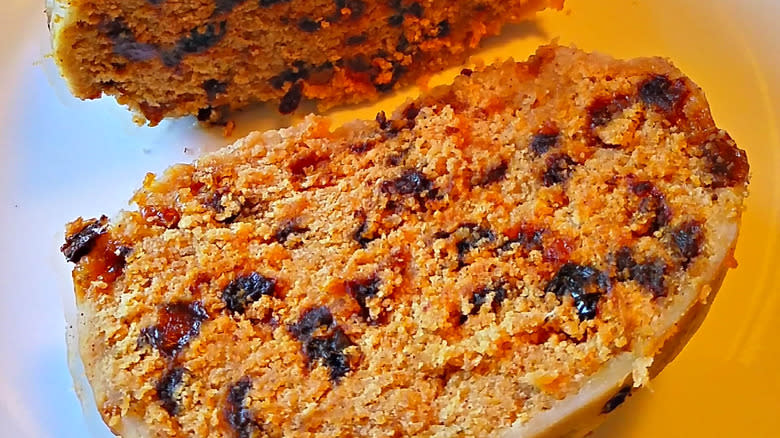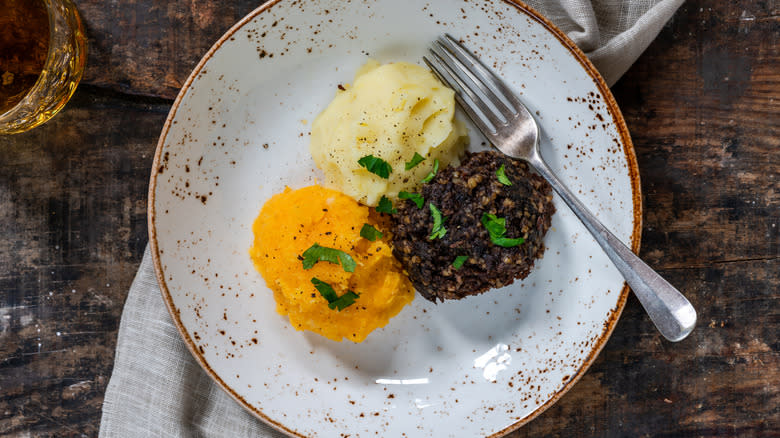What Is A Clootie Dumpling And How Did It Get Its Name?

The British Isles have an international reputation for interesting place names (welcome to Sheepy Magna) and culinary choices, and these uncanny talents into naming their traditional foods. Would you be interested in some bubble and squeak, spotted dick, or a chip butty? How about a clootie dumpling?
Gently spiced and beloved amongst the Scottish, a clootie dumpling is a steamed pudding, similar to a figgy pudding. It's less what we know as a dumpling, like a potsticker or pierogi, and more like a dense cake or bread studded with dried fruit. The strange name comes from the Scots language, where clootie comes from cloot, which means a piece of fabric or rag. The dumpling is boiled and wrapped in a cloth, usually a tea towel or piece of muslin, hence the name clootie dumpling. The origins of the clootie dumpling can be traced back to plum and Christmas puddings, for which a similar recipe first appeared in a cookbook written by English cook Hannah Glasse in 1747. When the clootie dumpling comes out of the water, it has a glutenous sheen to it that's crisped up in the oven and served with custard or ice cream -- a little dram of whisky wouldn't go amiss, either. A clootie dumpling strikes a fine balance between being sweet and savory, so oftentimes you'll also see it alongside a Scottish breakfast, or even on a cheeseboard.
Read more: French Cooking Tricks You Need In Your Life
Clootie Dumplings Play A Part In Several Scottish Traditions

As a classic Scottish dish, recipes have often been handed down by grandparents -- just like a Sunday gravy or arroz con pollo recipe, grandma has her own clootie dumpling recipe, and everyone else's is wrong. It's typically eaten around Christmas and Hogmanay, what the Scots call New Year. You'll sometimes find trinkets, charms, and coins wrapped in parchment paper baked into your slice. Traditionally, what you unearthed in your slice -- whether a horseshoe, a wishbone, or a bell -- would tell you what to expect in the future. Leftovers are served throughout the rest of the holiday season in a variety of forms, whether fried in a pan and eaten with breakfast or on its own.
Clootie dumplings are often served on Burns Night to celebrate the Scottish poet Robert Burns, where traditional Scottish foods are on offer. After a main dish of haggis is served, accompanied by a bagpiper and Burns' "Address to a Haggis" recited, clootie dumplings make an appearance. The rest of the evening is spent reciting Burns' most famous poems.
Making A Clootie Dumpling Is Pretty Straightforward, If A Bit Odd

Clootie dumplings have made more than one appearance on "The Great British Baking Show," with varying degrees of success. They're a fairly simple affair, but take a while to cook in the simmering water -- anywhere from three to four hours, and it's not a set and forget recipe; the water might need to be topped up as the dumpling cooks.
Recipes usually call for suet, which comes from the fat around the kidneys of cows, or sheep, but you can use margarine, or find a vegetarian suet. Spices like cinnamon, ginger, and dried fruits such as sultanas (golden raisins), currants, or apples get mixed with the suet and oatmeal to form a dense dough. You can find clootie dumplings with a wide range of fruits and flavors, from apple, pear, and cinnamon, to strawberry and Prosecco.
After the dough is prepared, it gets wrapped in the cloot -- a clean cotton tea towel, piece of muslin, or even a pillowcase will do. Before wrapping, the cloth must first be prepped, which is usually done by boiling the cloth and wringing it out, and then sprinkling generously with flour. As the dumpling cooks in the water, the flour gelatinizes and leaves a skin on the outside of the dumpling. In the 17th century, cooks would have left it by the fire to firm up, but modern conveniences allow us to put the dumpling in the oven. Then slice and serve with custard or cream and enjoy.
Read the original article on Daily Meal.

